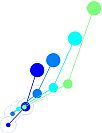In today's digital age, people have unprecedented access to vast amounts of negative information such as news about wars, environmental disasters, or economic collapse. While some people selectively avoid such distressing content, others persistently immerse themselves in such information, even to the detriment of their well-being and mental health – a phenomenon commonly known as doomscrolling. Here, we introduce a novel reinforcement learning model and empirically test its predictions to shed light on the origins of this maladaptive information-seeking behavior. First, by simulating human data, we showed that doomscrolling arises when the motivation to reduce uncertainty is higher than the motivation to improve affect through information-seeking; a pattern we term the “doomscrolling fingerprint”. Next, we tested these predictions in the real population using data from an information-seeking task (N = 190) and a follow-up survey (N = 104). Consistent with our model's predictions, participants who presented a doomscrolling fingerprint sought more negatively valenced information when performing the information-seeking task. Most importantly, these participants reported a greater incidence of doomscrolling in real-life behavior. Our study takes a significant step toward unraveling the intricate psychological mechanisms behind maladaptive information-seeking behaviors prevalent in today's digital age, paving the way to future behavioral interventions.

 PDF version
PDF version
